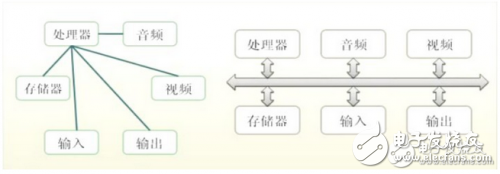Bus basic bus (Bus) is a common communication trunk that transfers information between various functional components of a computer. It is a transmission harness composed of wires. According to the type of information transmitted by the computer, the bus of the computer can be divided into a data bus, an address bus, and Control bus for transmitting data, data addresses and control signals. The bus is an internal structure, which is a common channel for the CPU, memory, input and output devices to transmit information. The various components of the host are connected by a bus, and the external device is connected to the bus through a corresponding interface circuit, thereby forming a computer hardware. system. In a computer system, a common path for transferring information between various components is called a bus, and the microcomputer is connected to each functional component by a bus structure. The bus works when the bus is idle (other devices are connected to the bus in a high-impedance state) and a device is to communicate with the destination device, the device that initiates the communication drives the bus, issuing the address and data. Other devices connected to the bus in a high-impedance state receive the data on the bus if they receive (or can receive) address information that matches their own. The transmitting device completes the communication and gives up the bus (the output becomes high impedance). A. By function and specification. Figure 1 The status and relationship of the three types of buses in the microcomputer system (1) Chip Bus (C-Bus), also called component bus, is an information transmission path that connects various chips together to form a specific function module (such as a CPU module). Its width can be 8. 16, 32 or 64 bits. Several popular internal bus technologies are currently available: I2C bus, SCI bus, etc. (2) Internal Bus (I-Bus) Also known as the system bus or board-level bus, it is the information transmission path between each plug-in (module) in the microcomputer system. For example, a transmission path between a CPU module and a memory module or an I/O interface module. Commonly used are PC bus, AT bus (ISA bus), PCI bus and so on. (3) External Bus (E-Bus), also known as communication bus, is the path for information transmission between microcomputer systems or between microcomputer systems and other systems (instruments, meters, control devices, etc.), such as EIA RS-232C, IEEE-488 and so on. The system bus, that is, the bus in the usual sense, generally has three different functions of the bus, namely the data bus DB, the address bus AB and the control bus CB. In some systems, the data bus and the address bus are multiplexed, that is, the signal that appears at some point in the bus represents data and the other represents the address; while some systems are separate. The address bus and data bus of the 51 series MCU are multiplexed, while the bus in the general PC is separate. The "data bus DB" is used to transfer data information. The data bus is a bidirectional tri-state bus, that is, it can transfer CPU data to other components such as memory or I/O interface, and can transfer data of other components to the CPU. The number of bits in the data bus is an important indicator of the microcomputer and is usually consistent with the word length of the microprocessor. For example, the Intel 8086 microprocessor has a 16-bit word length and a data bus width of 16 bits. It should be pointed out that the meaning of the data is generalized, it can be real data, it can be instruction code or status information, and sometimes even a control information. Therefore, in actual work, the data bus does not necessarily transmit. It's just data in the true sense. The "address bus AB" is dedicated to the transfer of addresses. Since the address can only be transferred from the CPU to the external memory or I/O port, the address bus is always unidirectionally tri-stated, which is different from the data bus. The number of bits in the address bus determines the size of the memory space that the CPU can directly address. For example, if the address bus of an 8-bit microcomputer is 16 bits, the maximum addressable space is 2^16=64KB, and the 16-bit microcomputer (x-bit processing) The address of the address that the microprocessor can handle in one clock cycle, that is, the word length, is 20 bits, and its addressable space is 2^20=1MB. In general, if the address bus is n bits, the addressable space is 2^n bytes. "Control Bus CB" is used to transmit control signals and timing signals. Some of the control signals are sent to the memory and I/O interface circuits, such as read/write signals, chip select signals, interrupt response signals, etc., and other components are fed back to the CPU, such as: interrupt request signal, reset Signal, bus request signal, device ready signal, etc. Therefore, the direction of transmission of the control bus is determined by the specific control signal, which is generally bidirectional. The number of bits of the control bus depends on the actual control needs of the system. In fact, the specific situation of the control bus depends mainly on the CPU. Piezo Buzzer,Dc Electro Magnetic Buzzer,Buzzer Acoustic Components,Piezo Buzzer For Thermometer Jiangsu Huawha Electronices Co.,Ltd , https://www.hnbuzzer.com
A buzzer or beeper is an audio signalling device, which may be mechanical, electromechanical, or piezoelectric (piezo for short). Typical uses of buzzers and beeper include alarm devices, timers, and confirmation of user input such as a mouse click or keystroke.